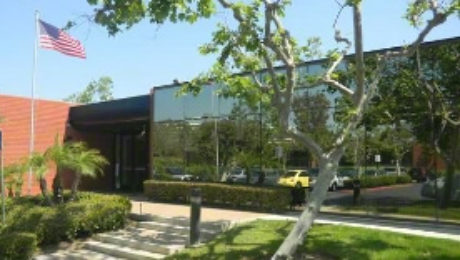He Turned Commercial Real Estate Upside-Down And Created A Worldwide Organization
The Orange County economy continues to boom into the new millennium after its devastating bust in 1989. That year marked the massive deterioration of commercial real estate, resulting in the dramatic increase in vacancy rates and the rapid decrease of rental rates. It was a devastating blow to the market.
It was also the year Barry Saywitz, president of The Saywitz Company, began his commercial real estate career in tenant representation in Orange County.
Mr. Saywitz’s entry into the commercial real estate arena could not have occurred at a worse time.However, his characteristic determination and drive carried him through the struggles of the early 1990s, and eventually his efforts began to pay off, bigger than he could have imagined.
In 1994 he agreed to purchase the West Coast operations of Howard Ecker & Company to form The Saywitz Company. It’s beginnings were modest, with a localized focus on the needs of corporate users in Orange County.
As the commercial real estate market began its slow recovery, Saywitz rode the wave. The company began negotiating transactions outside of Orange County, eventually opening a branch office in San Diego and then one in the San Francisco Bay area. It wasn’t long before Saywitz was negotiating real estate transactions across the country.
“We grew the company as we began doing business with corporations that were headquartered in California but had locations throughout the country”, he explains. “These companies had a comfort level with our ability to provide professional real estate services in California. Consequently, they entrusted us to negotiate transactions for other locations. We soon learned we needed some kind of vehicle to service these accounts in markets where we did not physically have a presence.”
Faced with this dilemma, Saywitz looked around at how the bigger national companies, and larger networks of commercial real estate brokerage firms, were able to sustain and service their existing client base. Through a careful analysis he was able to formulate a plan which would, ultimately, allow him to grow his business beyond his dreams.
This plan became central to the evolution of the CORE Network, a member owned organization of commercial real estate service providers. CORE offers clients comprehensive. services in real estate investment, management, development, strategic planning, tenant representation, acquisitions, disposition and finance.
Founded in 1996, the CORE Network has grown to become one of the largest commercial real estate organizations in the world, no small achievement for Barry Saywitz.
“The foundation of CORE expanded both the breadth and the depth of service and expertise available to our clients”, Saywitz explains. “We believe it is through the sharing of information and cooperative marketing that the level of service provided by all members is enhanced and our clients benefit from this collective effort. The CORE Network now provides market coverage at a greater capacity than any other real estate organization of its kind”.
Saywitz always envisioned affiliate CORE offices throughout the world. Today, CORE members are found in the United States, Canada, Mexico, Europe, and South America. There are more than 80 commercial real estate firms, with offices in more than 120 cities throughout the country, including more than 5,000 real estate professionals.
CORE’s primary focus is to expand its cutting edge technology services to members. It currently provides market demographic information as well as market comparison information on more than 65 major markets.
Additionally, the organization provides demographic and mapping software to its members and clients. It also provides project-tracking and real estate/site selection monitoring software. An advisory board of real estate experts provides CORE with industry updates and education.
As testimony to its success, CORE member firms negotiated transactions in 2001 that exceeded $17 billion, representing some of the largest transactions in their respective markets.
“We are in discussions with numerous organizations to expand our presence in Europe and Asia and make CORE the world’s largest and most proficient real estate organization”, explains Saywitz, who now serves as chairman of CORE.
The CORE Network has succeeded in building a highly competitive real estate alternative to the large national brokerage company. The combination of providing local market expertise with entrepreneurial companies and real estate professionals across the country has proven to be a successful formula.
Adds Saywitz, “The organization has well exceeded my expectations and has potentially changed the way commercial real estate is transacted on a national and global basis”.
When Barry Saywitz decided to enter the real estate market in that fateful year more than a decade ago little did he anticipate the bang he would get from the ’90s real estate boom. What he did know was that he had the entrepreneurial spirit, the vision, and the compelling passion that is the essence, and heart, of CORE.
Jennifer Moudy is a freelance writer residing in Long Beach.
- Published in Real Estate
Question: Are There Creative, Affordable Solutions To Finding A Suitable Building In A Tight Real Estate Market?
Barry Saywitz of California’s Saywitz Company gives one solution.
As the economy recovers, your company may need new and/or additional facilities to not only upgrade systems and equipment, but for future expansion. In some markets, vacancy rates are in the single digits, and you may need to turn to build-to-suit facilities to accommodate expansion due to the lack of available space.
The ultimate cost to your company with build-to-suit facilities is a function of the price of land, cost of construction, and the cost of money available to you or your developer. In many cases, these costs are in excess of current market rents for existing product, and although it allows your company to expand, there is additional financial commitment required.
The Saywitz Company, a national commercial real estate brokerage and consulting firm based in Orange County, CA, was faced with several scenarios for clients looking to expand throughout California. Many of the markets in California, like others around the country, are extremely landlord oriented and available space is scarce while rental rates are climbing.
We’ve implemented a concept to accommodate our client’s expansion plans and control real estate costs called the Purchase Partial Lease Back (PPLB). The PPLB incorporates the concepts of build-to-suit, purchase, and leasing scenarios all into one transaction.
The dynamics of the marketplace, financial stability of your company, future projections for the market, and your company’s growth must all be considered in this transaction. We’re currently using the PPLB throughout California, and have recently employed it for our own real estate requirements and growth for our new headquarters office in Newport Beach, CA.
The basic concept of the transaction is that you either purchase or construct a new facility to accommodate your company’s requirements. This new facility will be larger in size than your company’s immediate requirements in preparation for future company growth. Your company will then own the facility and lease back the portion of the facility you do not need immediately. The rental income that will be generated from your new tenant will offset in part, or in its entirety, your financial obligations for the new facility. This allows the flexibility to gradually grow into the facility while increasing your bottom line by reducing overall real estate costs.
The benefits of this transaction are:
- Ownership,rather than renting — The benefits of ownership provide tax incentives to the principals of the company, and projected appreciation of the asset as a whole provides additional upside to the company.
- Flexibility to control future growth — Your company can rent out the excess space for short- or long-term leasing to coincide with its future growth plans and gradually ease into the overall size of the building.
- Bottom line cost saving — When financial analysis are performed on a build-to-suit, lease transaction versus the the PPLB, the overall expense can range from 30%-100% in bottom-line cost savings to your company. Additionally, the lease that is signed with the tenant for the excess space in the building will typically have annual increases and your mortgage will stay fixed for the length of the mortgage. In time, your monthly expense decreases, as rental income increases.
The risks of PPLB are:
- Future down-turn in the real estate market — Although we are certainly on the up-cycle of the real estate market, should it take a downward turn, you may be left with an asset worth less than what you paid. However, as long as you use the facility, the cost will be cheaper than renting.
- Ownership responsibilities — You are responsible for maintaining the facility and coordinating any issues with your own tenants. With the PPLB, your company is, in effect, the landlord. However, these risks can be alleviated by hiring a third party manager at a nominal cost.
- Risk of finding a tenant — There are additional costs that may be incurred to you by having a portion of the facility remaining vacant for a period of time after construction or acquisition. This may alter the financial analysis and require additional up-front cost to be incurred until a tenant is found. However, in the typical case of the PPLB, this scenario requires a build-to-suit with new construction. In this case, your company will have a minimum of 6 to 12 months to market the property prior to the completion of the construction. Assuming this transaction is being structured in a market that has decreasing vacancies and increasing rental rates, there should be no difficulty in finding a tenant for new construction prior to the completion of the building.
As in any real estate transaction, there are risks and rewards. The risks with the PPLB are future stability of the real estate market, and the future business projections of your company.The rewards, however, will increase your bottom line performance significantly and control your future growth.
As the pioneer of this new concept, The Saywitz Company has taken its own advice and has purchased a building in Newport Beach, CA for its headquarters. The firm implemented the PPLB to alleviate all costs associated with real estate. In effect, the company eliminated the rent line item on its balance sheet and acquired an asset in the process. We are currently negotiating several transactions in excess of 1,000,000 square feet employing this concept.
If your company fits the criteria for this transaction and employs a solid set of investment analysis combined with future growth projections, you will be able to either acquire or construct a new facility allowing better efficiency and use of space, along with technological change. You will be able to place an asset on your balance sheets rather than a rent expense and reduce your overall real estate costs significantly.
Look for this type of transaction to continue to take place in those markets where suitable alternatives for space are difficult to find and in markets where rental rates and property values continue to increase. As companies look to increase bottom line profits, and control overhead expense, the PPLB affords them this opportunity.
- Published in Real Estate
Site Selection/Lease Negotiation and Much More Nationwide
A company can evolve in many ways. Most effectively, it evolves from vision, wisdom and instinct. Once a company exists, it faces competition, market pressures and many other challenges. One Orange County company evolved and uniquely acclimated itself to a dynamic and growing business clientele.
The Saywitz Company, with headquarters in Orange County, began its operations in 1985 and focused its business on successfully assisting the development of other companies. The Saywitz Company specializes in tenant representation, investment and real estate consulting.
The success of The Saywitz Company can be attributed to its team approach. Barry Saywitz, president, is both player and coach. Mr. Saywitz has a knowledge of the real estate business that, in turn, brings valuable insights to the business of his clients. He has been able to envision what his clients need, assess where the market is currently and where it is heading.
After earning a BS in Economics from UCLA, Mr. Saywitz graduated from the Dale Carnegie Institute. Subsequently, he obtained both his California real estate broker and general con-tractor licenses. Mr. Saywitz entered his professional career with Grubb & Ellis in San Diego. In 1989 he came to Howard Ecker & Company in Orange County, predecessor to The Saywitz Company.Soon Mr. Saywitz became the vice president of West Coast operations, and shortly thereafter, became a partner.
In 1994, Mr. Saywitz negotiated a buy-out of the West Coast operations of Howard Ecker &Company and changed the corporate name to reflect the change in ownership. Since that time,he has organized a company that effectively represents its clients and has established itself as a key player in the corporate real estate market.
“The Saywitz Company has been successful because of the organizational structure. We work as a team with the client as our main concern as opposed to each individual working for his/her own benefit”, said Mr. Saywitz. The Saywitz team benefits when the company as a whole does well. That depends solely on customer satisfaction.
This company makes itself valuable and effective in various ways. For example, the tenant representation services provide its clients unbiased, reliable representation. When it comes time to negotiate rent for office space, having The Saywitz Company on the tenant’s side will allow for negotiations in which both sides have a market-wide point of view. Furthermore, the tenants gains years of negotiation experience.
The tenant services that are provided include reviewing the current and future business activity of the client, reviewing its business plan, reviewing current location and market opportunities, developing an occupancy strategy, identifying options, negotiation the structure and terms of the lease, reviewing construction budgets, and much more.
The Saywitz Company begins with a proactive approach for the client and assists the client throughout the entire process and remains with the client after the negotiations to ensure everything is handled as the parties have agreed.
“Orange County is one of the hottest real estate markets in the country. The diversity of the businesses here is unlike other regions,” said Mr.Saywitz. “Here we have retail, distribution, manufacturing and professional businesses as opposed to other old line cities where the growth is not as dramatic due to lack of diversity and hi-tech businesses. Orange County is comprised of hi-tech software companies to beverage bottlers to clothing manufacturers. This diversity makes for a strong real estate market.
The Saywitz Company offers many additional services, including consulting, construction management, strategic planning, portfolio management, and facility acquisition services. A large part of the company’s business is lease negotiation, investment and real estate consulting.
The Saywitz Company’s style and effectiveness strengthens with the connection it has with The CORE Network. This is a network of commercial real estate service companies which span the country. Having envisioned the need for such an organization, Mr. Saywitz is the founder and the chairman of this non-profit organization.
The CORE Network consists of over 50 brokerage companies in approximately 100 cities.This network exists to assist firms that may need to venture out of their own local market. This enables The Saywitz Company to offer its clients that have real estate requirements outside of California, local expertise and information on market conditions and availabilities wherever their requirements may be.
The Saywitz Company assists its clients in achieving its goals and objectives, whether short or long term, by offering professional representation and real estate expertise. Given the complexities and importance of a company’s real estate transactions, including the costs, teaming-up with an experienced winner can assure rock-solid results.
The Saywitz Company has divisions in San Diego and San Francisco and is currently negotiating transactions throughout the country. Mr. Saywitz is a resident of Newport Beach.
- Published in Real Estate
Network Power
The CORE Network gives local brokers new reach
To compete with national real estate firms, local entrepreneurs have a choice either specialize in a niche or develop a national reach through networking. For one firm, that decision led to the creation of the CORE (Commercial Real Estate) Network, now comprised of more than 40 commercial real estate firms across the U.S, with annual total gross revenue topping $7 billion.
Barry Saywitz, president of the Saywitz Co., in Santa Ana, Calif., wanted to compete more effectively on a local basis and service his existing client base through an affiliation with local brokerage companies across the country.
“We were doing business in more than half of the states,” he recalls, “and in each instance we were cooperating with a local real estate company to assist us in providing local market knowledge and expertise. But these companies had no vested interest in our success, or in our clients’ needs. As a result, I saw the necessity to form an organization of companies that have similar goals and philosophies so that we could network, generate referrals, service our existing clients and build new relationships.
“Representatives of seven companies attended the first organizational meeting of the CORE Network in June of last year. These were Mr. Saywitz; Bishop Hawk of Sacramento, Calif,; Ryon & Associates of Tampa, Fla.; Wolf Commercial Broker age in Los Angeles; Bullock, Terrell & Mannelly in Atlanta; Bussell Realty in Edison, N.J.; and Corporate Facilities Group in Boston. At its August 1997 convention in Chicago, the organization had grown to 42 firms with offices in more than 60 cities nationwide.
Among the firms are some of the most successful companies in the industry.Member firm Trinity Asset Management in San Antonio, Texas recently completed the largest commercial real estate transaction in the history of the city, a deal whose aggregate elements are valued at more than $130 million. The initial discussion that led to the transaction occurred at a network meeting earlier this year.
And still, the network grows. Recent additions include Swearingen Realty Group of Dallas; U.S. Equities of Chicago; Cassidy & Pinkard of Washington, D.C.; Williamson, Picket,Gross of New York City; Chaney Brooks &Co. of Honolulu; and Stiles Realty Co. of Miami.
“Our affiliation with CORE has not only provided us with greater capabilities to service our existing client base but has created opportunities for us to expand locally and nationally,” says William Lawley, principal of the Swearingen Co. and a member of CORE’s board of directors.
The fact that another network of commercial real estate companies is now available indicates how strong the industry has been for the past several years. Nine of the CORE Network member firms were founded in the past decade.
The organization has been managed essentially from its beginning by its board of directors, with the recent addition of M.Scott Rickard as executive director. Mr. Rickard comes to his post with a background in accounting (with Arthur Andersen & Co.) as well as in national marketing, financial analysis and commercial real estate management. He is now responsible for day-to-day operations and marketing of the organization as it continues on its expansion path.
“The number of transactions that have been consummated through CORE in such a short period of time is remarkable,” says Mr. Rickard. “Member firms have completed transactions in all 50 states, Canada, Mexico, Asia and Europe.”
That success rate, he continues, “reinforces the fact that local real estate companies must expand to survive and grow. The CORE Network allows local firms to become national in scope, and ultimately international, without physically expanding their operation.
The organization supports each of its member firms by staying current with changes in technology and trends in the industry. An advisory board has been formed to consult the network, comprising executives from such real estate related industries as insurance, law and accounting.The organization also assists other key industry organizations in their support of legislative issues critical to the well-being of the industry, the executive director says.
“There was never a doubt in my mind that there was a need for an organization like this,” says Mr. Saywitz. “What has been pleasantly surprising is that there are so many real estate firms around the country that have similar goals. The other members of the organization are my business partners, and we work together to grow all of our businesses.”
- Published in Real Estate
Superstar Office Leasing Brokers
Annual showcase of the industry’s leading dealmakers
Taken as a whole, the nation’s office leasing market is moving toward an equilibrium of supply and demand. Unlike the 1980s and early ’90s when the negotiating table tipped in favor of one side or the other, there’s plenty of opportunity today for owners and ten-ants alike to strike a favorable agreement.
But while the playing field has been leveled, the overall game strategy has shifted. Leasing professionals are working smarter, offering their clients services that go beyond finding or filling space.
“I see a growing demand for real estate services that enable corporate clients to track occupancy performance such that they truly under-stand what they have, what they need and how to achieve it,” says H. Hetherington Smith, a corporate vice president in the Philadelphia office of Julien J. Studley Inc.
For agency reps, William Cohen, executive vice president of Newmark & Co. Real Estate Inc., says there’s a premium on “repositioning buildings to match market demand, i.e, upgrading premises if necessary to attract upscale tenants; pre-building space for users who need facilities in move-in condition; and working closely with tenants,sometimes moving them within the building or relocating them, in order to create large blocks of space within the property.”
These are but some of the tools that separate the nation’s top leasing brokers from the also-rans.
REAL ESTATE FORUM asked firms across the country to nominate those members of their teams who best use these tools and qualify as superstar office leasing brokers. This listing, arranged alphabetically, is not a ranking nor is it meant to be judgmental in any way. While not every entry received made it into our pages, the final selection was determined by the thoroughness of the submission. All information was accurate as of press time.
- Published in Real Estate
OC Commercial Real Estate Booms
Commercial rental rates continue to rise as the commercial real estate market herein Southern California continues its recovery. The current trend of increased office rents throughout Orange County and particularly near John Wayne airport have forced some tenants to relocate. The bargain prices for class A office space that were seen in the early 90’s have disappeared and the companies who signed leases at the bottom of the real estate market are now faced with expiring leases and dramatic rent increases. In many instances, tenants renewing their leases must choose between a 30-50% rent increase or the cost and disruption of relocation to more affordable space. The days of free parking in the structures of high rise buildings have vanished; free rent and improvement allowances have decreased significantly as well.
Other segments of the commercial real estate market are beginning to follow this trend in office rents. Industrial and R&D buildings have seen steady rent increases with the vacancy rates for these types of buildings decreasing on a monthly basis. Retail rent shave begun to increase as well with the replacement of under performing tenants and the elimination of long-standing vacancies. As a retail center becomes fully leased, all of the tenants benefit from greater traffic flow and increased exposure. This adds value to the center and ultimately adds to the increase in rental rates.
As the economy recovers and vacancy rates continue to fall, rents will rise accordingly. As for the tenants; serious considerations will have to be given to the type of building and utilization of space in order to maximize their layout and control rising real estate costs. Companies will begin to reevaluate issues of geo graphics and quality of building as noted by the recent decisions of the Fluor Corp. and Western Digital to relocate from high rise office space to a more cost effective and efficient low rise alternative. The astute tenant will begin to analyze its alternatives well in advance of their lease expiration. The need for new and/or additional space will need to be addressed proactively rather than reactively. The more lead time the company has to make decisions relative to their real estate, the greater opportunity they have to hedge against future increases in the real estate market and make the most prudent business decisions.
One way to ensure that real estate costs are controlled and all options are explored, is by utilizing the service of professional real estate experts to assist in the strategic planning, forecasting and implementation of the company’s real estate plans. The Saywitz Company, headquartered in Santa Ana, is a national real estate brokerage and consulting firm which specializes in assisting tenants in relocating, renewing their existing leases and strategic planning for the future. The real estate market is now in full recovery mode. There are more potential buyers of commercial real estate in Orange County than there are opportunities. This reversal of supply and demand combined with decreasing vacancy and a solid economy will cause rental rates to climb over the next 12 to 18 months.
Tenants should realize what the market is doing and plan ahead for the future. This may require the realization that your rent will in crease significantly or that you may need to read just your office requirements to fit your budget. Sophisticated tenants will utilize the services of companies like The Saywitz Company to hedge against future increases by planning in advance and hiring professional negotiators to implement their real estate plan. If you are an investor of commercial real estate, your time has come. If you are a tenant that has had a lease with inexpensive rent for the past several years, you will be faced with difficult decisions and increased bottom line costs. Regardless of which side of the table you are sitting, landlord, tenant, buyer, or seller, all options should be considered care-fully.
Although the future of commercial real estate in Orange County looks bright, one should not forget that only a short time ago we were faced with rock bottom rental rates and soaring vacancies. The investor and user of real estate who lives for today and plans for the future will reap the benefits of a sound business decision.
- Published in Real Estate
Local real estate company expands nationally through network affiliation
As the commercial real estate market continues to recover in Orange County, as well as across the country, many real estate brokerage firms have decided to expand their operations. Some have grown through acquisition, some through mergers and others through the opening of new offices around the country. Orange County is one of the most active real estate markets in the country and is home to branch offices and corporate headquarters of every major real estate brokerage company, as well as numerous local houses. As the age of the Internet continues to evolve and information becomes more accessible, each company looks to be more competitive than the next. The recovering real estate market has spurred an expansion of the industry.
One locally headquartered company has taken a unique approach to its desire to expand and compete more cost effectively in the market place. The Saywitz Company headquartered in Santa Ana with branch offices in San Diego and San Francisco has joined forces with 50 other real estate companies across the country to form a network partnership affiliate in more than 90 cities across the country. The CORE Network is a network of local and regional privately held real estate companies that have joined forces to compete more effectively on a national and international basis. The Saywitz Company is the affiliate for San Diego and Orange County and has already received benefit from this newly formed organization.
The CORE Network was founded in April 1996 by two Southern California real estate brokers, Barry Saywitz, president of The Saywitz Company head-quartered here in Orange County and Alan Wolf, president of Wolf Commercial Brokerage in Los Angeles with the intent that this organization would someday include business partners throughout the country and around the world. The vision of these two entrepreneurs is now a reality. The CORE Network today is one of the largest organizations of its kind and encompasses affiliate offices in more cities than any national real estate company. The organization, headquartered in Orange County continues to expand its presence and is expected to have 75-100 firms in more than 125 cities throughout the U.S. by next year.
The success of The CORE Network is a direct correlation to the need for local real estate companies to be a part of a national presence to compete effectively for business. The Saywitz Company’s need for this type of organization is twofold says Barry Saywitz, chairman of the Network, “First we have expanded our operation throughout the state of California, but the ramp up time and cost to expand across the country is prohibitive”. The CORE Network allows us the ability to network, share business, and collectively pursue expanding our client base without physically expanding our company. Second, since we are negotiating real estate actions in 25-30 states currently, we felt the need to have a local presence to assist us in these transactions.
“I had no idea that the concept would be so well received by so many firms around the country. Additionally, I am extremely impressed with the quality and caliber of our business partners and their commitment to achieve a common goal”, says Saywitz.
The CORE Network according to Saywitz plansto expand its organization throughout North Americaand ultimately worldwide. It is currently speaking with companies all over the world that have interest in aligning themselves with the organization. The CORENetwork was designed under the same structure as theNational Football League. This unique format allows each member firm to be a partner in the organization. Since The CORE Network is a non-profit organization,the proceeds from business that is transacted among the partners directly benefits each partner and those funds are used to expand the services of the organization.
Saywitz holds high praise for the organization, as he has already conducted business with more than half of his partners and is currently working on several sizable requirements here in Southern California.
- Published in Real Estate
California’s Economy Bounces Back
After years of economic struggles, the Golden State is back in business
The California commercial real estate market is rebounding after seven years of economic struggles and a prolonged period of increased vacancies,decreased rental rates, and devaluation of commercial properties. So has California’s economy turned the corner, and if so, how will it affect commercial real estate markets throughout the state?The answer is that the economic recovery of the entire country has finally reached the West Coast, and all indicating factors point toward a strong economic recovery for the state. This has spurred an increased demand for commercial real estate throughout the state by investors around the globe. The past 12 months have seen rental rates for office,industrial, retail, and apartment space increase dramatically. Current interest rates and increased lending by financial institutions have allowed purchasers of commercial properties a better ability to acquire new properties and expand their portfolios. In addition, the resurgence of the REITs and their abundant source of capital − combined with offshore and Wall Street money − have created an excess supply of capital and have driven prices for commercial properties to all-time highs for the 1990s. The state’s economic and demographic growth will continue to spur advances in the real estate market and create a new phase in this cycle of the real estate economy. As vacancy rates continue to drop and rental rates and purchase prices continue to increase, demand will continue to exceed supply, thereby creating the need for build-to-suit and speculative development in the later half of 1998 and early 1999. Following is a brief look at each of the state’s major economic centers and the factors driving those particular markets.
San Diego
The southernmost economic center of the state is San Diego County, comprised of approximately 10 sub markets, each with it sown unique focus and pricing schedules. The downtown, UTC, and Carlsbad markets comprise the majority of the office sectors. Miramar, Kearny Mesa, Poway, and Oceanside comprise the warehousing and manufacturing sectors, while the Torrey Pines, Sorrento Valley, and portions of the Carlsbad market comprise the biotech and R&D components of the market. While each of these sub markets focuses on specific pricing, the San Diego commercial real estate market as a whole was rated as the No.1 market in the country for the first half of 1997 by one of the nation’s largest real estate magazines for increased rental rates overall.The majority of large blocks of office, industrial, and R&D space are not available, and many users are looking to build-to-suits to accommodate their needs.A majority of the land owners in San Diego County have recently refrained from selling raw land to users and developers because prices for raw land have increased dramatically, and these large land owners would rather build and hold the property than short-sell it today and preclude them-selves from future benefits. Most of the new development in San Diego County appears to be in North County, where the majority of the residential development is as well.Prospects for the San Diego commercial real estate market are high, as it continues to be one of the most desirable places in the country to live and work.
Orange County
Orange County has seen dramatic rebounds in its economy, governmental stability, and commercial real estate viability.Real estate continues to be one of the highest driving forces in the overall economy, and future speculative development in North and South Orange County continues to pave the way for growth. The region’s bankruptcy appears to have been put to bed, and stability has returned.Orange County has seen increases across the board in office, industrial, and retail pricing. The John Wayne Airport area has seen one of the highest increases in office rental rates in the entire country. Over the past six months, office rents have increased in excess of 25%, and in some cases almost 100%. Office vacancy in Class A product is in single digits, and rental rate pricing has reached levels that will now justify future developments. The industrial sector is just beginning its rent spike now that vacancy rates have dipped below 10%. A majority of the big box users are looking to build-to-suits, because the product available for them simply does not exist. Expect rental rates and purchase prices to continue to increase in Orange County, and look for a significant amount of new build-to-suit and speculative development, particularly in South Orange County.
Los Angeles
Los Angeles County is the largest economic center in the state, if not the country.Along with its neighboring counties, it is comprised of numerous sub markets, too many to outline in detail. The L.A. commercial real estate market is just now coming into its own in terms of increased rental rates. The significant amount of over-supply during the early 1990s and widespread default of over leveraged properties put L.A.’s commercial real estate markets in the doldrums for an extended period of time.However, the commercial real estate market is back, and industry-watchers can expect prices to continue to rise at a rapid pace over the next 12 to 18 months. As older and dilapidated projects continue to be rehabilitated and redeveloped, this creates a new market and pricing structure.
In addition, there are new developments of previously uninhabited land throughout Los Angeles that bring new economic prosperity to that particular region. The resurgence of growth in the North Valley − particularly in the Northridge, Encino, and Woodland Hillsareas − continues where the earthquake had caused problems with older properties.Office prices on L.A.’s west side are rising rapidly and should reach the figures that we saw in the late 1980s within the next 12 to 24 months.Downtown Los Angeles, which has suffered for a number of years, has now reached a point of equilibrium, where rental rates are increasing at a steady pace. The number of mergers, acquisitions, and consolidations among corporate headquarters downtown has stunted this area of L.A.’s recovery; however, the availability of quality office facilities downtown continues to dwindle, which will aid in this area’s recovery.Many of the manufacturers and distributors previously headquartered in Los Angeles made a mass exit during the early 1990s to more cost-effective parts of the country, such as Las Vegas, Arizona,Colorado, and Northern California. For the most part, the exit of these companies is over, and those businesses that remain in Southern California are here to stay.However, a good number of such companies have chosen to relocate to more cost-effective parts of Southern California to provide them greater economic profitability.
Inland Empire
The Inland Empire consists of Riverside and San Bernardino Counties and is located south and east of Los Angeles and east of Orange County. It has continued to thrive over the past few years, and possesses great potential for economic growth and continued development due to the vast amount of vacant land and affordable pricing. Many companies have chosen to relocate regional distribution centers due to the ease of accessibility to San Diego, Los Angeles, and other states via freeway access and rail. The vast amount of vacant warehouses has continued to decrease and is at the point now where new speculative development is being seen.Much of this area’s growth is attributed to low-income, affordable housing. As the migration further east continues, more businesses will look to located in this area.
San Jose & Silicon Valley
The San Jose commercial real estate market has seen dramatic changes over the past 18 months. The continued population growth and technological advances of computer and high-tech companies have caused a shockwave throughout the commercial real estate markets. Pricing for office space has increased in excess of 30%, and in some cases in excess of 100%, from previous years.The lack of available land for development of commercial properties and the increased needs for expansion of Silicon Valley’s commercial inhabitants have caused a serious shortage of available product, both for office and industrial space. This increased demand has driven rental rates and purchase prices to astronomical levels relative to previous pricing. Vacancy is in the low single digits and new speculative development is continuing to increase. This real estate market is one of the hottest suburban office markets in the country, and rental rates are some of the highest in the nation.Look for the commercial real estate market in San Jose to continue to thrive as new developments in and around central San Jose continue to flourish. As for the Peninsula and Silicon Valley, the lack of available land for development creates additional strains on the equilibrium of supply and demand. Ultimately, companies head-quartered in these areas will look to relocate portions of their operations outside of the area because there is physically no place for them to be located.
San Francisco
San Francisco, which has been rated as the most expensive place to live in the country, is now probably the most expensive place to work as well. The cost of commercial office space downtown has reached an all-time high, with rents for Class A office space in the financial district in excess of $5 per square foot/month. The dramatic increase in rental rates in the downtown area have not only reached all-time highs, but the recovery from the rental rates and vacancies of the early 1990s hit with such swift impact that many companies were faced with rental rate increases of 50% to 100% overnight. The vacancy rate for downtown San Francisco is also one of the lowest in the country with availability for apartment housing in San Francisco at less than 1%.Many companies located in San Francisco are forced to relocate operations across the bay, where there is a greater supply of land and pricing is moderately more inexpensive.San Francisco continues to be the hottest real estate market in the country in terms of pricing and vacancy rates.
East Bay
The East Bay is comprised of Oakland and the surrounding cities. The region has,for the past several years, struggled in terms of vacancy rates and pricing. However, many companies have chosen to locate along the east side of San Francisco Bay due to more favorable pricing, available opportunities,and lack of other places to go. The overall economic rebound has significantly helped revitalize downtown Oakland rental rates and the vacancy rates in surrounding cities.Although rental rates are significantly less than those on the Peninsula or in downtown San Francisco, they are continuing to rapidly increase as the vacancy rates continue to drop. Many companies whose employees commute from the East Bay will choose to locate here instead of other parts of the Bay due to decreased commute times and more favorable real estate costs.
Sacramento
The state capital, long considered an agricultural area and government headquarters, has continued to develop its own identity and business community. Again, the forces driving businesses out of the San Francisco Bay Area have brought many distribution and manufacturing companies to Sacramento. The availability of vacant land,decreased pricing in terms of rental rates,and availability of a more inexpensive labor force provide positive economic factors which corporations have taken advantage of.The continued population growth and the relocation of many firms have driven rental rates upward over the past 12 months.Vacancy rates in Sacramento for office space continue to decline at a steady pace, and rental rates continue to increase. The avail-ability of land for master-planned development and its comparatively less-expensive pricing have allowed this region to continue to flourish.
An Optimistic Outlook
California is one of the most diverse states in the country and continues to be one of the highest growth states as well. While national sources expect economic growth across the country to increase at 3.5% to 3.75%, inflation remains around 2.2%.Consumer confidence is at an all-time high,and demand for commercial real estate remains increasingly optimistic.While we must learn from our mistakes and experiences in the 1980s, the economic growth of the 1990s and into the 21st century will provide a new list of issues and circumstances. For investors and users of commercial real estate, their goals and objectives’− as well as future trends in the market − must be examined by both today’s standards and future projections. Those who elect to invest in commercial real estate and apply a solid set of investment techniques and applications will prove to have made wise investments decisions.
- Published in Real Estate
- 1
- 2








